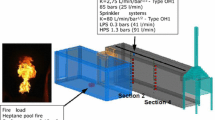Abstract
The purpose of this study is to investigate the descending air current of a smoke layer for smoke logging during sprinkler operation. The results could be used for performance-based evacuation safety design. Smoke layers were investigated experimentally using particle image velocimetry (PIV) and were analyzed according to the size of the fire source and the type of sprinkler head. As a result, a relationship was obtained between the mean droplet diameter, droplet velocity, and spray distribution for each sprinkler head. In addition, the descending air current of smoke was studied as a function of the fire source size and the velocity of the descending air current. It was predicted by the regression equation that the smoke layer moved to the bottom layer when the descending air current speed reached 0.6 m/s and confirmed that a stable descending air current was generated only when the fire source size exceeded 100 kW.
Access this chapter
Tax calculation will be finalised at checkout
Purchases are for personal use only
Similar content being viewed by others
Abbreviations
- A d :
-
Cross-sectional area (m2)
- B :
-
Buoyancy force of the smoke layer (N/m)
- C D :
-
Drag coefficient (-)
- D′:
-
Resistance force for the drag water droplets (N)
- g :
-
Gravitational acceleration (m/s2)
- ΔH C :
-
Heat of combustion (kJ/g)
- m b :
-
Burning rate (g/s)
- m d :
-
Water droplet mass (kg)
- n :
-
Particles per unit volume number (-/m3)
- n i :
-
Particle diameter (μm)
- Q :
-
Heat release rate (kW)
- R e :
-
Reynolds number (-)
- r :
-
Radius of the water droplet (m)
- T s :
-
Smoke layer temperature (K)
- T 0 :
-
Lower layer temperature (K)
- v d :
-
Vertical particle velocity (m/s)
- W :
-
Sprinkler watering spray amount (kg/m2∙s)
- \( \overline{x} \) :
-
Sauter mean diameter (μm)
- x i :
-
Number of particles (-)
- μ :
-
Viscosity (Pa∙s)
- ρ :
-
Smoke layer density (kg/m3)
- ρ s :
-
Smoke layer air density (kg/m3)
References
Bullen ML (1977) The effect of a sprinkler on the stability of a smoke layer beneath a ceiling. Fire Technol 13(1):21–34
Chu BG, Choi JW, Cha KS (2001) The study on characteristics of water spray and droplets from fire sprinkler head. J KIIS 16(2):13–21
Kim SC (2012) A numerical study of the effect of sprinkler spray on the flow characteristics induced by fire. J Korea Inst Fire Sci Eng 26(5):105–110
Kim DS, Park YI, Park HY (1993) An experimental study on the responsiveness of sprinkler heads. J Korea Inst Fire Sci Eng 7(2):3–12
Kim MB, Han YS (1996) Prediction of sprinkler activation time in compartment fire. J Korea Inst Fire Sci Eng 10(4):13–18
Kim JH, Kim WH, Lee SK (2001) A comparison of the prediction of sprinkler response time applying fire models. J Korea Inst Fire Sci Eng 15(2):46–52
Kim SC, Lee SW, Park WJ (2009) A sensitivity study of the number of parcels to the numerical simulation of sprinkler sprays. J Korea Inst Fire Sci Eng 23(1):48–54
Kwon YJ et al. (2012) Fire dynamics for PBD, Dong hwa Publisher, pp. 261–271
Lee BK, Tae SH (1991) A study on response time index and operating time for fusible link sprinkler head. J KIIS 6(4):34–44
Li KY, Hu LH, Huo R, Li YZ, Chen ZB, Li SC, Sun XQ (2009) A mathematical model on interaction of smoke layer with sprinkler spray. Fire Saf J 44(1):96–105
Li KY, Li MJ (2011) Simplified calculation method for determining smoke downdrag due to a sprinkler spray. Fire Technol 47(3):781–800
NFSC 103 (2014) National fire safety code for sprinkler equipment. Notification of Ministry of Public Safety and Security
Tsuchiya M, Matsuyama K (2012) A study on smoke behavior affected on droplets of sprinkler, velocities of the droplets and smoke layer by PIV system, Ph. D. degree of Tokyo University of Science
Park WC, Lee MG, Park HS (2006) Simulation of a clean room fire II. Need of smoke control system and sprinkler system. J Korea Inst Fire Sci Eng 20(2):8–13
Park YH (2004) Directional water spray characteristics of sprinkler heads. J Korea Inst Fire Sci Eng 18(4):35–41
Zhang CF, Chow WK, Huo R, Zhong W, Li YZ (2010) Experimental studies on stability of smoke layer with a sprinkler water spray. Exp Heat Transf 23(3):196–216
Acknowledgments
This work was supported by grants of the National Emergency Management Agency that showcase our Fire Safety Technology Development (“NEMA-Next Generation-2011-30”).
This work was supported by the Center for Fire Science and Technology, Research Institute for Science and Technology, Tokyo University of Science.
Author information
Authors and Affiliations
Corresponding author
Editor information
Editors and Affiliations
Rights and permissions
Copyright information
© 2017 Springer Science+Business Media Singapore
About this paper
Cite this paper
Seo, DG. et al. (2017). An Experimental Study on the Smoke-Logging Phenomenon Using Sprinkler for Performance-Based Evacuation Safety Design. In: Harada, K., Matsuyama, K., Himoto, K., Nakamura, Y., Wakatsuki, K. (eds) Fire Science and Technology 2015. Springer, Singapore. https://doi.org/10.1007/978-981-10-0376-9_88
Download citation
DOI: https://doi.org/10.1007/978-981-10-0376-9_88
Published:
Publisher Name: Springer, Singapore
Print ISBN: 978-981-10-0375-2
Online ISBN: 978-981-10-0376-9
eBook Packages: EngineeringEngineering (R0)




